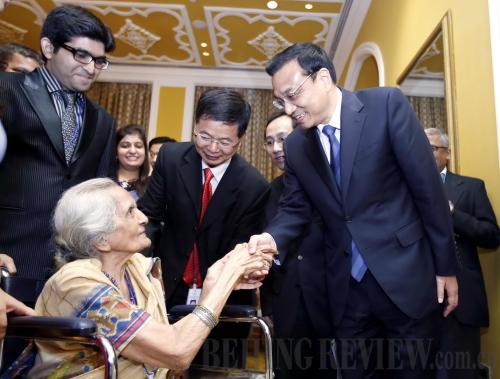|
 |
|
DEEP FRIENDSHIP: Chinese Premier Li Keqiang meets with Manorama, sister of Dr. Dwarkanath Kotnis who died in China while providing medical aid during World War II, in Mumbai on May 21. The Indian physician provided medical aid to China during World War II (JU PENG) |
It is widely acknowledged that the backward infrastructure of India has become a bottleneck for the country's pursuit of rapid development. The two big blackouts last year in India, affecting the lives of 360 million and 680 million people respectively, caused awkward moments for the country on a global scale.
Lou said China's wealth of funds, experience and technology in infrastructure construction offers it big advantages to India in terms of cooperation. China has become the largest overseas project contractor of India. Even so, much room is still left for additional projects.
China, which has advantages in manufacturing, is now faced with pressing problems as material and labor costs continue to rise in the domestic market. But in the meantime, a research report released by Kunming-based Yunnan University shows 51 percent of the Indian population are younger than 25 and in 2025 India will have about 130 million extra workers available to the world.
Sun claims that it would be a good choice for China's manufacturing sector, troubled by surging labor prices at home, to transfer business to India. At the same time, it would provide an opportunity for India to improve its manufacturing industry and create more jobs. Some economists also noted that only when India develops a more mature manufacturing base, can it achieve trade parity with China.
Trust building
China and India, both of which fought against semi-colonial or colonial rule, enjoy traditional friendship. However, exchanges between the two countries were interrupted by a border conflict in 1962.
Lou said the border dispute has severely hindered mutual trust. In the joint statement issued during Li's visit, both sides agreed to work together to maintain tranquility and peace in the border areas.
To address the newly emerging trade imbalance, the two sides agreed to improve ties between Chinese enterprises and the Indian IT industry, and expand border trade through the Nathu La border port. They also made an agreement on trade in buffalo meat, which could help redress the trade imbalance as Chinese demand for the meat is potentially worth $1.5 billion a year.
Cooperative projects concerning security issues are also included in the joint statement, which observers say could help promote mutual trust. They include expanding civil nuclear energy programs, enhancing cooperation on maritime security, holding joint military exercises as well as strengthening cooperation in naval escort missions to counter piracy in the Indian Ocean.
Email us at: yulintao@bjreview.com
Areas of Cooperation
- Bilateral relations: improving political trust and the great potential for trade and investment growth
- International issues: climate change, reform of the international system and protection of the shared interests of developing countries
- Regional outreach: development of the China-India-Myanmar-Bangladesh economic corridor and consensus on Afghanistan's reconstruction
Points of Contention
- Territory: The 2,000-km border between China and India has never been formally demarcated
- Tibet: India hosts the Dalai Lama's "Central Tibetan Administration," which the Chinese Government accuses of attempting to separate Tibet from China
- Trade deficit: India ran a trade deficit of $28.87 billion with China in 2012
- Third party: India is cautious about China's close ties with its neighboring rival Pakistan | 